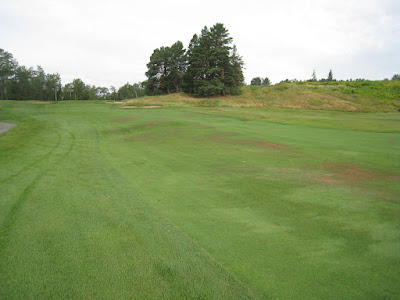We see them each summer; as you play the golf course in July and August you will notice some areas on fairways have a brown tinge to them. The photo above shows some these areas on the third hole. Over the past five seasons we have seen areas such as this become less and less around the golf course; the reason for the reduction are numerous.
- We have reduced our thatch layer from nearly four inches to two inches or less. Many of the areas are the result of hydrophobic thatch being unable to gain moisture from rain or irrigation.
- Aeration, aeration, aeration-over the past five seasons we have aerated the fairways 17 times, in one form or another. This aeration has broken down thatch and deepened root systems as well as creating avenues for water and air to reach the soil system.
- Wetting Agents-This season, for the first time, we have applied a wetting agent to our fairways. This addition along with our aeration program has greatly increased the ability of rain and/or irrigation to wet the thatch and soil, thereby creating more consistent fairway conditions.
Despite all of these improvements we still see some areas on fairways drying our faster than most areas. In most cases this is due to the very thin soils found on the hillside holes of 2, 3, 15 and 16. These hole are built on top of ledge rock and many of the dry areas have soil only three to four inches deep. There are multiple options for dealing with areas such as this.
- Over-water the dry areas using over-head irrigation-this results in the non-dry areas of the fairways being far too wet, leading to many other issues.
- Hand-water the dry areas using hoses and lots of man-power. If we had the budget and the increased labor force that comes with it, then hand-watering would be an option. In our case, it is not.
The photo above is an up close shot of an area on 15 fairway in which the population of fine fescue is very high. The photo below shows the same area from further away. Areas on 1, 2, 14, 15, 16 and 18 fairways, which in the past we have struggled to produce good turf, have been seeded with fine fescue. Over the past couple of years the fescue has really began to emerge on these fairways and the turf conditions have dramatically improved because of it. We have also seeded fescue into many of our tee boxes and their conditions has also improved drastically.
With each summer season we identify these dry areas of fairways and use our Turfco slit seeder to seed various fine fescue species and varieties into the existing fairway turf. Fine fescue is by nature a slow-growing turf. While establishment is slow, once they are present in a stand of turf fine fescues provide a hearty, deep-rooted, low-input turf producing a fantastic playing surface.
If you live in Minnesota you know how poor the Gopher Football team has been for the past 50 years. Recently I read an interview with new coach Jerry Kill. In the interview he talked of how he and his staff are working to build the program on a foundation of concrete, rather than sand. They are working to building something that will last for years and years; exactly what we are doing with our fairways. By seeding fescue into dry areas we are solving a problem as opposed to treating symptoms. When you treat symptoms you must do so day after day, year after year. Solve the problem properly and it is unlikely you will deal with the problem again. Another way we practice sustainable turfgrass management at Northland Country Club.




EmoticonEmoticon